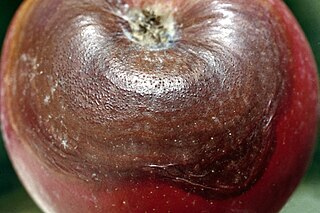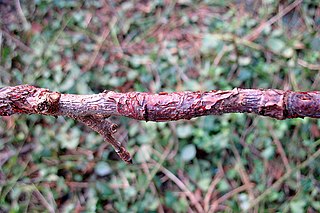
A plant canker is a small area of dead tissue, which grows slowly, often over years. Some cankers are of only minor consequence, but others are ultimately lethal and therefore can have major economic implications for agriculture and horticulture. Their causes include a wide range of organisms as fungi, bacteria, mycoplasmas and viruses. The majority of canker-causing organisms are bound to a unique host species or genus, but a few will attack other plants. Weather and animal damage can also cause stress to the plant resulting in cankers. Other causes of cankers is pruning when the bark is wet or using un-sterilized tools.

Citrus canker is a disease affecting Citrus species caused by the bacterium Xanthomonas. Infection causes lesions on the leaves, stems, and fruit of citrus trees, including lime, oranges, and grapefruit. While not harmful to humans, canker significantly affects the vitality of citrus trees, causing leaves and fruit to drop prematurely; a fruit infected with canker is safe to eat, but too unsightly to be sold. Citrus canker is mainly a leaf-spotting and rind-blemishing disease, but when conditions are highly favorable, it can cause defoliation, shoot dieback, and fruit drop.

Phytophthora palmivora is an oomycete that causes bud-rot of palms, fruit-rot or kole-roga of coconut and areca nut. These are among the most serious diseases caused by fungi and moulds in South India. It occurs almost every year in Malnad, Mysore, North & South Kanara, Malabar and other areas. Similar diseases of palms are also known to occur in Sri Lanka, Mauritius, and Sumatra. The causative organism was first identified as P. palmivora by Edwin John Butler in 1917.

Botryosphaeria obtusa is a plant pathogen that causes frogeye leaf spot, black rot and cankers on many plant species. On the leaf it is referred to as frogeye leaf spot; this phase typically affects tree and shrubs. In fruit such as the apple, cranberry and quince, it is referred to as black rot, and in twigs and trunks it causes cankers.

Neonectria ditissima is a fungal plant pathogen. It causes cankers that can kill branches of trees by choking them off. Apple and beech trees are two susceptible species.

Nectria cinnabarina, also known as coral spot, is a plant pathogen that causes cankers on broadleaf trees. This disease is polycyclic and infects trees in the cool temperate regions of the Northern Hemisphere. N. cinnabarina is typically saprophytic, but will act as a weak parasite if presented with an opportunity via wounds in the tree or other stressors that weaken the tree's defense to the disease. A study published in 2011 showed that this complex consists of at least 4 distinct species. There are only a few ways to manage this disease with techniques such as sanitation and pruning away branches that have the cankers. N. cinnabarina is not as significant a problem as other Nectria spp., some of which are the most important pathogens to infect hardwood trees.
Phytophthora citrophthora, also known as brown rot of citrus, is a soil borne oomycete that infects several economically important citrus crops. A diagnostic symptom of P. citrophthora is gummosis, wherein lesions around the base of the tree exude sap. Other common symptoms include dark longitudinal lesions forming at the soil line, a sour smell, and eventual cracking of the bark. Advanced symptoms include yellowing and necrosis of the tree canopy. Girdling action caused by the pathogen around the trunk can often cause the collapse of the tree. Resistant lemon varieties have been developed and their implementation has been effective at controlling the spread of the disease. Fruits that have been infected with P. citrophthora exhibit symptoms of brown rot characterized by a distinct odor. This disease is most active in the moderate temperatures of spring, fall, and winter months, opposite of most other Phytophthora species.

Cephaleuros virescens is an algal plant pathogen that infects tea, coffee and coconut plants, causing algal leaf spot or algal rust.
Phytophthora megakarya is an oomycete plant pathogen that causes black pod disease in cocoa trees in west and central Africa. This pathogen can cause detrimental loss of yield in the economically important cocoa industry, worth approximately $70 billion annually. It can damage any part of the tree, causing total yield losses which can easily reach 20-25%. A mixture of chemical and cultural controls, as well as choosing resistant plant varieties, are often necessary to control this pathogen.

Moniliophthora perniciosa is a fungus that causes "witches' broom disease" (WBD) of the cocoa tree T. cacao. This pathogen is currently limited to South America, Panama and the Caribbean, and is perhaps one of the best-known cocoa diseases, thought to have co-evolved with cocoa in its centre of origin.
The plant pathogenic fungus Leucostoma kunzei is the causal agent of Leucostoma canker, a disease of spruce trees found in the Northern Hemisphere, predominantly on Norway spruce and Colorado blue spruce. This disease is one of the most common and detrimental stem diseases of Picea species in the northeastern United States, yet it also affects other coniferous species. Rarely does it kill its host tree; however, the disease does disfigure by killing host branches and causing resin exudation from perennial lesions on branches or trunks.
Eutypella canker is a plant disease caused by the fungal pathogen Eutypella parasitica. This disease is capable of infecting many species of maple trees and produces a large, distinguishable canker on the main trunk of the tree. Infection and spread of the disease is accomplished with the release of ascospores from perithecia. Therefore, the best way to manage the Eutypella canker is to remove trees that have been infected. If infected, it can decrease the quality of wood cut for lumber and can thus have a negative economic impact.
Rosellinia bunodes is a plant pathogen infecting several hosts including avocados, bananas, cacao and tea.

Cacao swollen shoot virus (CSSV) is a plant pathogenic virus of the family Caulimoviridae that primarily infects cacao trees. It decreases cacao yield within the first year of infection, and usually kills the tree within a few years. Symptoms vary by strain, but leaf discoloration, stem/root swelling, and die-back generally occur. The virus is transmitted from tree to tree by mealybug vectors. It was first discovered in Ghana in 1936, and is currently endemic in Togo, Ghana and Nigeria. Over 200 million trees have already been claimed by this disease, which has prompted Ghana to launch the most ambitious and costly eradication effort of any country in the world against a viral plant disease.

Phytophthora kernoviae is a plant pathogen that mainly infects European beech and Rhododendron ponticum. It was first identified in 2003 in Cornwall, UK when scientists were surveying for the presence of Phytophthora ramorum. This made it the third new Phytophthora species to be found in the UK in a decade. It was named Phytophthora kernoviae after the ancient name for Cornwall, Kernow. It causes large stem lesions on beech and necrosis of stems and leaves of Rhododendron ponticum. It is self-fertile. It has also been isolated from Quercus robur and Liriodendron tulipifera. The original paper describing the species, stated it can infect Magnolia and Camellia species, Pieris formosa, Gevuina avellana, Michelia doltsopa and Quercus ilex. Since then many other plants have been identified as natural hosts of the pathogen. Molecular analysis has revealed that an infection on Pinus radiata, recorded in New Zealand in 1950, was caused by P. kernoviae. The pathogen was also noted on Drimys winteri, Gevuina avellana, Ilex aquifolium, Quercus ilex, Vaccinium myrtillus, Hedera helix, Podocarpus salignas.

Fusarium circinatum is a fungal plant pathogen that causes the serious disease pitch canker on pine trees and Douglas firs. The most common hosts of the pathogen include slash pine, loblolly pine, Monterey pine, Mexican weeping pine, and Douglas fir. Like other Fusarium species in the phylum Ascomycota, it is the asexual reproductive state of the fungus and has a teleomorph, Gibberella circinata.
Leucostoma canker is a fungal disease that can kill stone fruit. The disease is caused by the plant pathogens Leucostoma persoonii and Leucostoma cinctum (teleomorph) and Cytospora leucostoma and Cytospora cincta (anamorphs). The disease can have a variety of signs and symptoms depending on the part of the tree infected. One of the most lethal symptoms of the disease are the Leucostoma cankers. The severity of the Leucostoma cankers is dependent on the part of the plant infected. The fungus infects through injured, dying or dead tissues of the trees. Disease management can consist of cultural management practices such as pruning, late season fertilizers or chemical management through measures such as insect control. Leucostoma canker of stone fruit can cause significant economic losses due to reduced fruit production or disease management practices. It is one of the most important diseases of stone fruit tree all over the world.
Black pod disease is a fungal disease of Cocoa trees. This pathogen if left untreated can destroy all yields; annually the pathogen can cause a yield loss of up to 1/3 and up to 10% of total trees can be lost completely.

Pine-pine gall rust, also known as western gall rust, is a fungal disease of pine trees. It is caused by Endocronartium harknessii, an autoecious, endocyclic, rust fungus that grows in the vascular cambium of the host. The disease is found on pine trees with two or three needles, such as ponderosa pine, jack pine and scots pine. It is very similar to pine-oak gall rust, but its second host is another Pinus species. The fungal infection results in gall formation on branches or trunks of infected hosts. Gall formation is typically not detrimental to old trees, but has been known to kill younger, less stable saplings. Galls can vary from small growths on branch extremities to grapefruit-sized galls on trunks.











